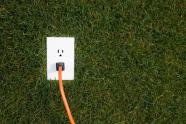Differences Between Energy Efficiency and Demand Response
Why should consumers care?

When asked by an energy-savvy professional to explain the difference between energy efficiency and demand response, my response came easily. But when asked a follow up about why this person should care what the difference is, I was more perplexed.
The expert was a neighbor who knows exactly what he pays per kilowatt-hour for electricity; has changed his light bulbs, wherever possible, to compact fluorescent light bulbs (CFLs), and put the rest on dimmers; shuts off lights and unplugs electronics chargers whenever they're not in use; and manages his thermostat settings closely. Despite his knowledge and his inherent energy-efficiency mindfulness, he is still unclear about the differences between demand response and energy efficiency, and he still didn't know why he should care about which is which. And that was just the beginning of the conversation.
This got me to thinking. I'm sure he's not alone in his questions. I turned first to the Web site for the National Action Plan on Energy Efficiency, where I found a wealth of information, from the plan's Vision for 2025 to guides, tools and fact sheets designed to assist state policy-makers, energy consumers, utilities and environmental groups to better understand the options available to them.
And then I unearthed "Coordination of Energy Efficiency and Demand Response," a report published in January 2010 as a resource to assist those advancing the National Action Plan for Energy Efficiency's goal of achieving all cost-effective energy efficiency by 2025.
Written by Charles Goldman (of the Lawrence Berkeley National Laboratory) and Michael Reid (E Source's research director), with assistance from Roger Levy and Alison Silverstein, this 74-page report, though now a year old, still clearly resonates as 2011 begins. For the benefit of my neighbor, as well as for utilities working to find more effective ways to communicate with their consumers, I'd like to share a few of the report's insights.
"There are significant differences in how energy efficiency and demand response are measured, what organizations offer them, how they are delivered to customers, and how they are rewarded in the marketplace," the authors state. "Reducing these differences and coordinating energy efficiency and demand response programs at the provider level could bring about cost efficiencies and more rational allocation of resources for both program providers and customers. Coordination could help customers, as most customers do not understand or care about the difference between energy efficiency and demand response and would be receptive to an integrated, packaged approach to managing their energy usage.
"Greater customer willingness could also increase demand response market penetration and capture energy savings and customer bill-reduction opportunities that might otherwise be lost," the report went on to note.
Customer Education
So, the argument is definitely there for customer education in the differences between demand response and energy efficiency, as well as the opportunities provided by both. But what about the "significant differences" in approach noted? Can the approach to demand response become more homogenous with that of energy efficiency? Can they be packaged similarly, or in conjunction with one another, to take better advantage of the energy savings produced by both?
Under the large umbrella of consumer education, which is clearly increasing in importance, comes the most logical answer, one that should be quite easy for utilities to embrace. Among other suggestions, the authors advise coordinated program marketing and education. "Without merging the delivery of services at the program level," they wrote, "program sponsors (e.g., utilities) could package and promote energy efficiency and demand response in a closely coordinated or unified way.
"Energy efficiency and demand response can be complicated topics, requiring sophisticated customer effort and action, so program sponsors should offer education that addresses both topics under a broad energy management theme," the report stated.
Given that many utilities aren't getting wonderful grades from their customers when surveyed about smart grid, smart metering, time-of-use pricing and other utility activities, I'd like to suggest demand response and energy efficiency programs and measures offer electric utilities a prime inroad to begin a true two-way conversation with their customers.
Many, like my questioning neighbor, who is long retired and on a limited monthly income, have been practicing energy efficiency for years in order to keep their electricity bills manageable. He certainly doesn't want demand response or energy efficiency mandated, as he's all for individual choice, but he doesn't want to see others get monetary bonuses for being Johnny-come-latelies to the efficiency table, either. His question (another I couldn't easily answer): "So I lose, because I was an early adopter? Because I've already cut back on my energy usage as much as I can, and others haven't, they'll be seduced into doing so by bonuses? What about me?"
I use this one neighbor as an example, but I've heard the same story over and over again in the past few years. It's an issue forward-looking utilities are going to have to address sooner rather than later. While two-way communications, data analytics and more may soon blur the distinctions between demand response and energy efficiency on the utility side of the fence, consumers, by and large, are still ... dare I say it ... in the dark.
Kate Rowland is editor of Intelligent Utility magazine.
Copyright © 1996-2010 by CyberTech, Inc. All rights reserved.
To subscribe or visit go to: http://www.energycentral.com
To subscribe or visit go to: http://www.energybiz.com